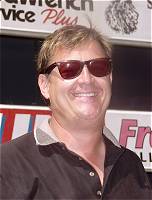
TV or Not TV
9/7/04
  here
is still nothing compelling about our current
version of the NHRA/ESPN television broadcast.
According to the latest listing in the Los Angeles
Times, ratings are still down and I’ve
got to blame NHRA management, the show’s
director and the announcers. They are all at
fault. here
is still nothing compelling about our current
version of the NHRA/ESPN television broadcast.
According to the latest listing in the Los Angeles
Times, ratings are still down and I’ve
got to blame NHRA management, the show’s
director and the announcers. They are all at
fault.
Let’s look at it this way. NHRA pays
ESPN handsomely for the coverage of 23 events;
NHRA pays for the video trucks, cameras, cables,
crews and the announcers. ESPN pays a licensing
fee to NHRA, but this is effectively a bought
and paid-for infomercial to support the NHRA
major sponsors and sell the NHRA brand of drag
racing entertainment to you, the rabid fan,
and Joe Six-Pack who happened to stumble across
the broadcast after the sixth inning of the
Little League World Series.
An infomercial may seem harsh, but how is this
broadcast different from an infomercial for
sales wizard Ron Popiel’s Showtime Rotisserie
Oven, except for the product? A salesman like
Popiel builds excitement about every aspect
of his product from the patented flavor injector
to the four easy payments, and he makes you
feel good about it!
When a new viewer finds an NHRA national event
on ESPN he should find every positive aspect
of drag racing. I’m not talking about
a Fantasyland version, but recent broadcasts
have focused on lawsuits, team orders and how
potentially unsafe the Top Fuel cars are. This
puts NHRA POWERade Drag Racing into a perpetual
bad light, fostered by the announcers. The show
has devolved into a sloppy, haphazard version
of 60 Minutes instead of the greatest show in
motorsports we all know.
It’s apparent that some of the announcers
have been influenced by Internet bulletin board
gossip and DRO, but this kind of investigative
reporting is better off being handled by independent
journalists rather than paid announcers from
the sanctioning body. If you watch NASCAR broadcasts,
as I do, you will seldom find anything coming
from an announcer’s mouth that could be
considered detrimental to the image of NASCAR
and NASCAR will impose a fine for being unfavorable.
Take a look at a current copy of National Dragster
or NHRA.com to read the positive aspects of
our sport, not an ongoing exposé on drag
racing. You won’t find the gossip of who
ran over Bob Glidden’s pit bike, the latest
sponsor scuttlebutt, lawsuits, who’s screwing
whom or multicar “team orders”.
A proclamation like “here come team orders”
before the national television audience makes
NHRA POWERade Drag Racing sound like a scripted
WWE wrestling show to the casual viewer, yet
it continues to be brought it up. We take you
to Memphis, July 22, 2004, Funny Car eliminations
round two: team owner John Force vs. employee
Gary Densham. In a somber Bill Stephens’
voice, “We’ve talked about this
a lot over the season; team orders - John Force
always says they race each other until they
get to Indy. They look at the points and then
if they need some help they make decisions based
on that. We are a week ahead of Indy, what’s
going to happen here?”
Force runs a low e.t. of eliminations with
his 4.906 308.78 and Densham smokes the tires
while Marty asserts, “You are going to
have to draw your own conclusions folks.”
Stephens then says to Force, “The armchair
second guessers will have their way.”
Aren’t you one of those armchair second
guessers? You have let us in on one of the big
insider secrets of modern drag racing, throwing
the game, the fix and the choke. Did it happen
or didn’t it? Leave this subject the hell
alone!
None of this negativity is contributing to
any possible rise in the ratings. Sorry to spill
the beans here, but when a viewer watches the
WWE Show, there is an assumption that it’s
a scripted show, now just like drag racing.
Here’s another Bill-ism:
While Brady Kalivoda and Joe Hartley staged
after their burnouts on the Memphis ESPN TV
qualifying show our insider, Bill Stephens,
made an interesting observation. He said, “Mike
(Dunn) just to add to what you say about the
performance kinda comin’ back to these,
ya know B-list teams, we also have had a lot
more clean racing. We have not had big boomers
and a lot of equipment getting blown up, so
the 85 percent rule has actually been a benefit
on both ends.”
In the short term 85 percent nitro does seem
to have made a big difference on equipment carnage,
but I’ve got to ask which drivers are
on your top fuel B-list? Is the B-list agreed
upon between NHRA, ESPN and their announcers?
Is being relegated to the B-list performance-based
or influenced by a driver’s sponsor and
if that sponsor is also a major NHRA sponsor?
If we didn’t have B-list Top Fuelers the
fields would be pretty thin; NASCAR calls them
field-fillers.
How does a driver or team make a move onto
this A-list? Is the A-list why Brandon Bernstein
gets a top-end interview and special pit reports
with the ESPN crew, even when he loses? Since
Larry Dixon is not a player for the POWERade
Championship this year did he move to the B-list
or did he make it back onto the A-list with
his team’s Memphis win? Is there a similar
B-list for Funny Cars and pro stock?
Since the ESPN announcer/actors are the insiders
on this show, rather than inserting themselves
into a real or imagined controversy, please
shut up and give us the racing. Please, let
us hear the cars and please, turn up the volume!

|